air condition Mercury Mountaineer 2002 Owner's Manuals
[x] Cancel search | Manufacturer: MERCURY, Model Year: 2002, Model line: Mountaineer, Model: Mercury Mountaineer 2002Pages: 312, PDF Size: 3.02 MB
Page 19 of 312
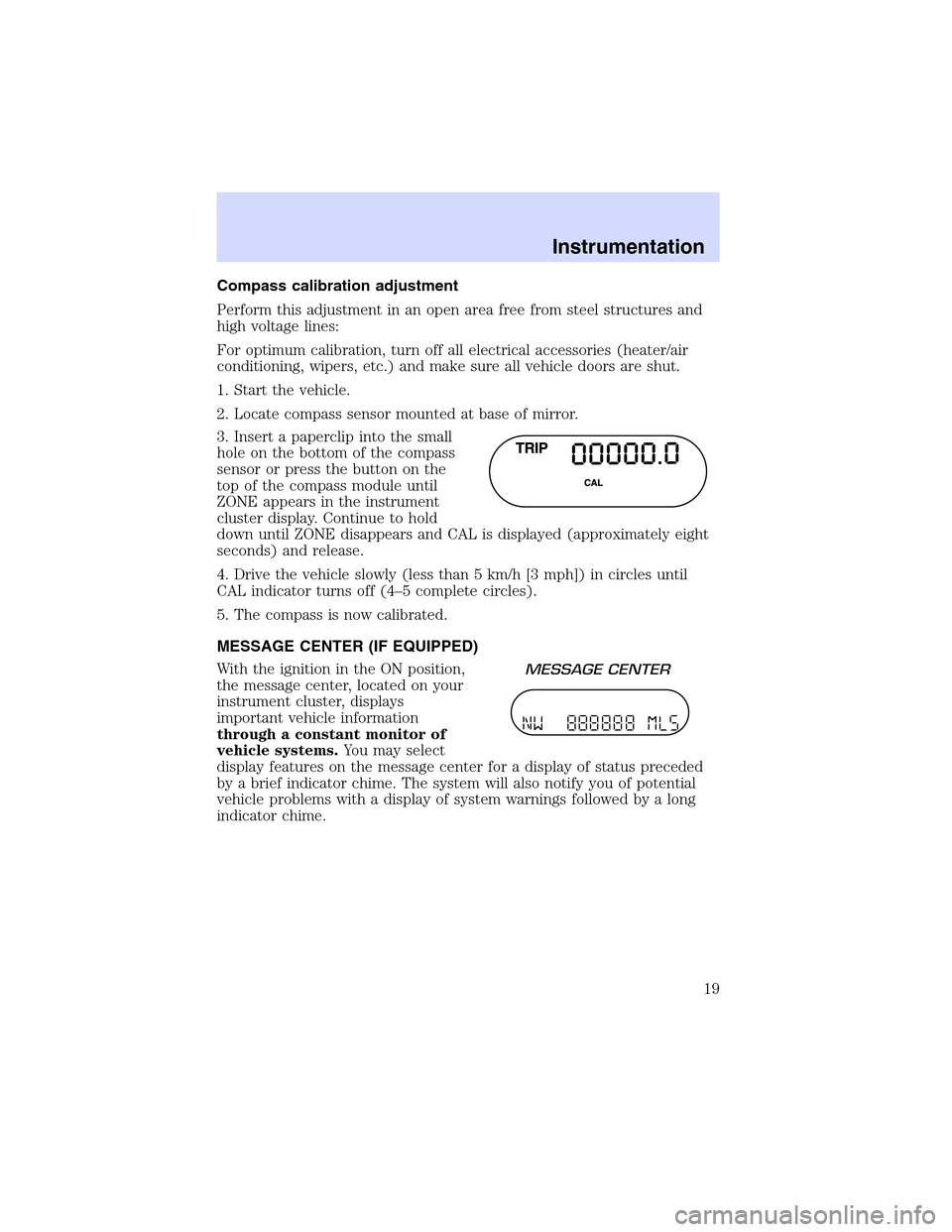
Compasscalibrationadjustment
Perform this adjustment in an open area free from steel structures and
high voltage lines:
For optimum calibration, turn off all electrical accessories (heater/air
conditioning, wipers, etc.) and make sure all vehicle doors are shut.
1. Start the vehicle.
2. Locate compass sensor mounted at base of mirror.
3. Insert a paperclip into the small
hole on the bottom of the compass
sensor or press the button on the
top of the compass module until
ZONE appears in the instrument
cluster display. Continue to hold
down until ZONE disappears and CAL is displayed (approximately eight
seconds) and release.
4. Drive the vehicle slowly (less than 5 km/h [3 mph]) in circles until
CAL indicator turns off (4–5 complete circles).
5. The compass is now calibrated.
MESSAGE CENTER (IF EQUIPPED)
With the ignition in the ON position,
the message center, located on your
instrument cluster, displays
important vehicle information
through a constant monitor of
vehicle systems.You may select
display features on the message center for a display of status preceded
by a brief indicator chime. The system will also notify you of potential
vehicle problems with a display of system warnings followed by a long
indicator chime.
Instrumentation
19
Page 21 of 312

degreesbetweenadjacent zones and will become noticeable as the
vehicle crosses multiple zones. A correct zone setting will eliminate this
error. Refer toCompass zone/calibration adjustment.
Compass zone/calibration adjustment
Perform this adjustment in an open area free from steel structures and
high voltage lines.
For optimum calibration, turn off all electrical accessories (heater/air
conditioning, wipers, etc.) and make sure all vehicle doors are shut.
1. Turn ignition to the ON position.
2. Start the engine.
3. Determine your magnetic zone by
referring to the zone map.
4. From Info menu, select the
Compass/Odometer function. (Do
not select Trip, DTE, or AFE. The
top of the message center must be
blank).
5. Press and hold the RESET and
SETUP control until the message
center display changes to show the
current zone setting.
6. Release the RESET AND SETUP
control, then slowly press RESET
down again.
7. Press the SETUP control
repeatedly until the correct zone
setting for your geographic location is displayed on the message center.
To exit the zone setting mode press and release the RESET control.
8. Press the RESET control to start
the compass calibration function.
1 2 3
4
5
6 7 8 9 101112 13 14 15
Instrumentation
21
Page 36 of 312
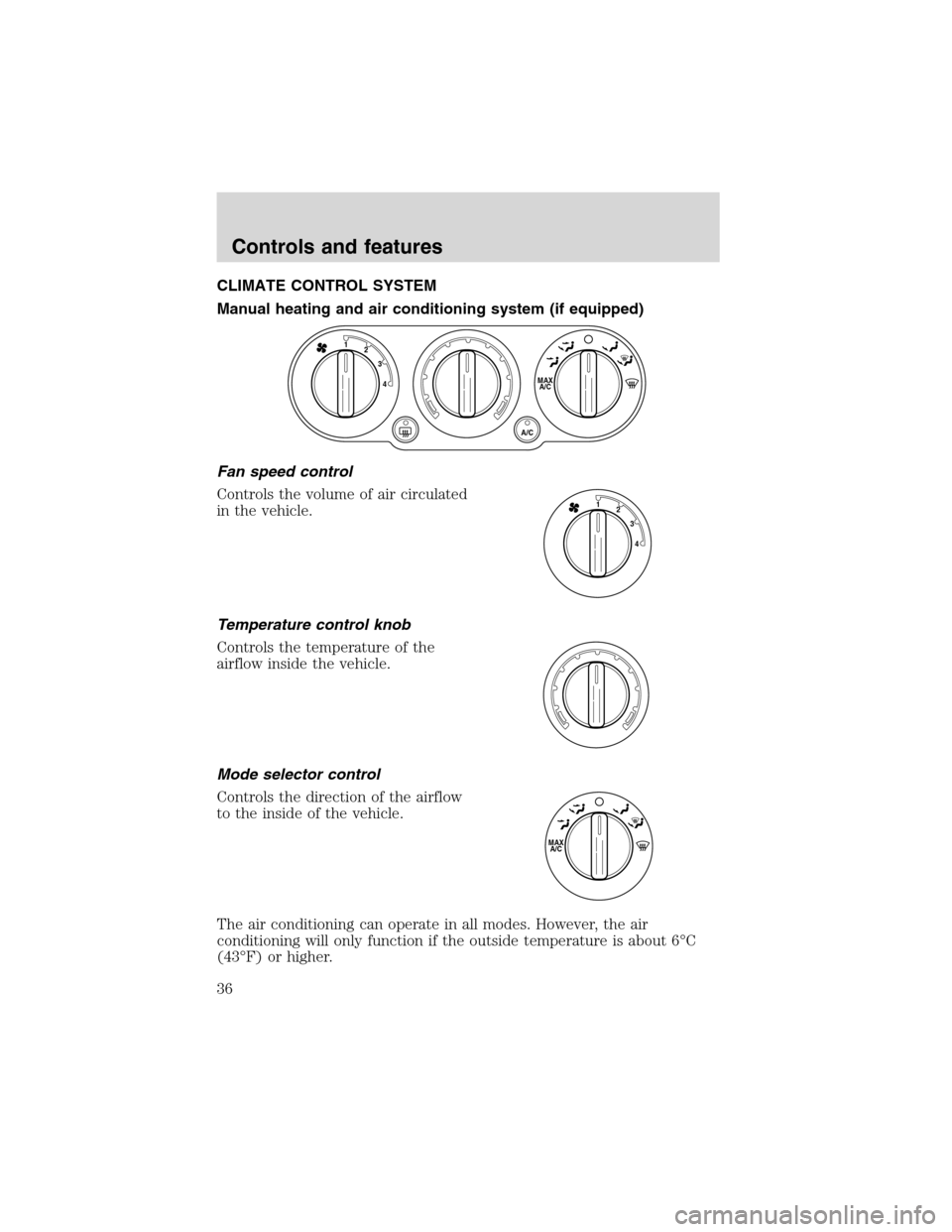
CLIMATE CONTROL SYSTEM
Manual heating and air conditioning system (if equipped)
Fan speed control
Controls the volume of air circulated
in the vehicle.
Temperature control knob
Controls the temperature of the
airflow inside the vehicle.
Mode selector control
Controls the direction of the airflow
to the inside of the vehicle.
The air conditioning can operate in all modes. However, the air
conditioning will only function if the outside temperature is about 6°C
(43°F) or higher.
4MAX
A/C
A/C 3 2 1
4 3 2 1
MAX
A/C
Controls and features
36
Page 37 of 312
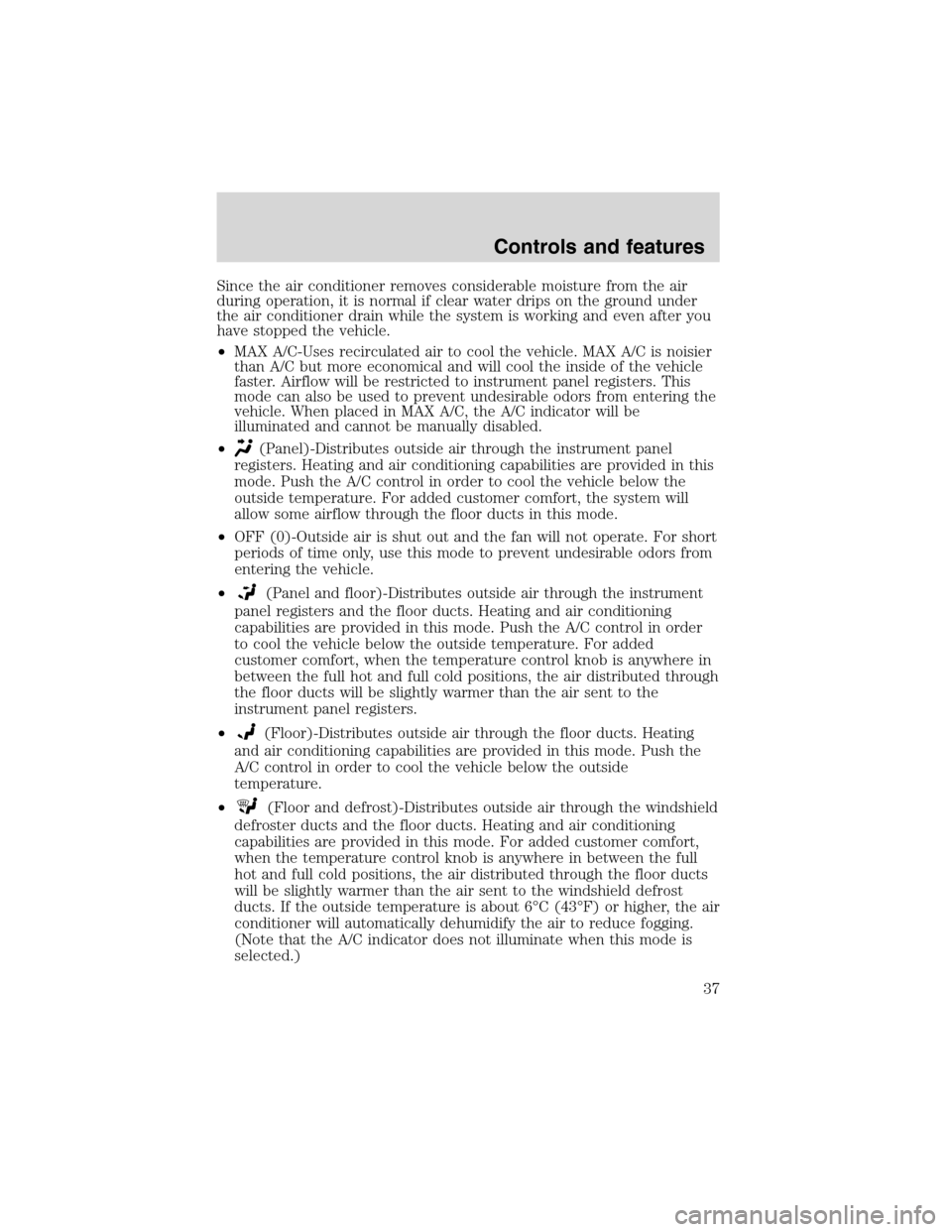
Since the air conditioner removes considerable moisture from the air
during operation, it is normal if clear water drips on the ground under
the air conditioner drain while the system is working and even after you
have stopped the vehicle.
•MAX A/C-Uses recirculated air to cool the vehicle. MAX A/C is noisier
than A/C but more economical and will cool the inside of the vehicle
faster. Airflow will be restricted to instrument panel registers. This
mode can also be used to prevent undesirable odors from entering the
vehicle. When placed in MAX A/C, the A/C indicator will be
illuminated and cannot be manually disabled.
•
(Panel)-Distributes outside air through the instrument panel
registers. Heating and air conditioning capabilities are provided in this
mode. Push the A/C control in order to cool the vehicle below the
outside temperature. For added customer comfort, the system will
allow some airflow through the floor ducts in this mode.
•OFF (0)-Outside air is shut out and the fan will not operate. For short
periods of time only, use this mode to prevent undesirable odors from
entering the vehicle.
•
(Panel and floor)-Distributes outside air through the instrument
panel registers and the floor ducts. Heating and air conditioning
capabilities are provided in this mode. Push the A/C control in order
to cool the vehicle below the outside temperature. For added
customer comfort, when the temperature control knob is anywhere in
between the full hot and full cold positions, the air distributed through
the floor ducts will be slightly warmer than the air sent to the
instrument panel registers.
•
(Floor)-Distributes outside air through the floor ducts. Heating
and air conditioning capabilities are provided in this mode. Push the
A/C control in order to cool the vehicle below the outside
temperature.
•
(Floor and defrost)-Distributes outside air through the windshield
defroster ducts and the floor ducts. Heating and air conditioning
capabilities are provided in this mode. For added customer comfort,
when the temperature control knob is anywhere in between the full
hot and full cold positions, the air distributed through the floor ducts
will be slightly warmer than the air sent to the windshield defrost
ducts. If the outside temperature is about 6°C (43°F) or higher, the air
conditioner will automatically dehumidify the air to reduce fogging.
(Note that the A/C indicator does not illuminate when this mode is
selected.)
Controls and features
37
Page 38 of 312
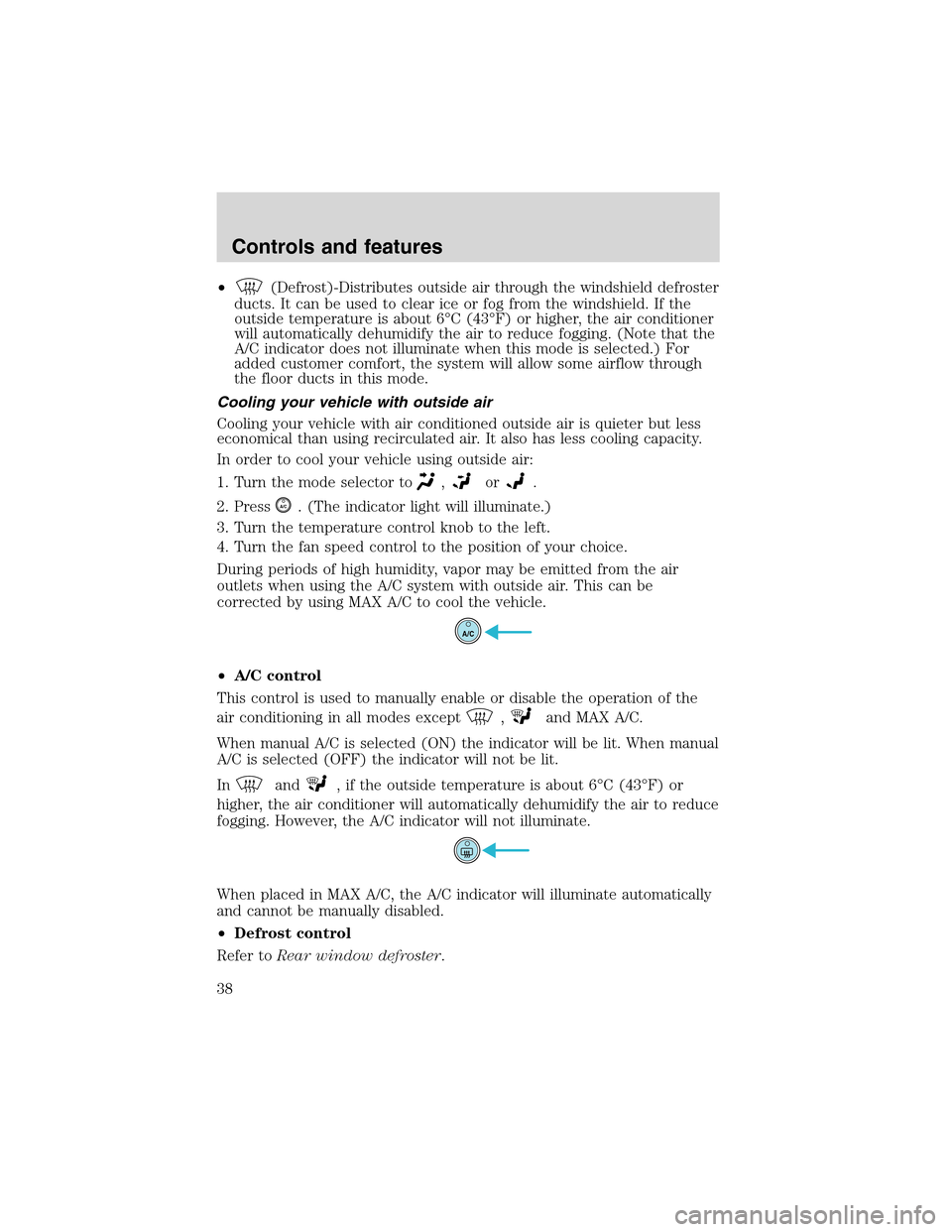
•(Defrost)-Distributes outside air through the windshield defroster
ducts. It can be used to clear ice or fog from the windshield. If the
outside temperature is about 6°C (43°F) or higher, the air conditioner
will automatically dehumidify the air to reduce fogging. (Note that the
A/C indicator does not illuminate when this mode is selected.) For
added customer comfort, the system will allow some airflow through
the floor ducts in this mode.
Cooling your vehicle with outside air
Cooling your vehicle with air conditioned outside air is quieter but less
economical than using recirculated air. It also has less cooling capacity.
In order to cool your vehicle using outside air:
1. Turn the mode selector to
,or.
2. Press
A/C. (The indicator light will illuminate.)
3. Turn the temperature control knob to the left.
4. Turn the fan speed control to the position of your choice.
During periods of high humidity, vapor may be emitted from the air
outlets when using the A/C system with outside air. This can be
corrected by using MAX A/C to cool the vehicle.
•A/C control
This control is used to manually enable or disable the operation of the
air conditioning in all modes except
,and MAX A/C.
When manual A/C is selected (ON) the indicator will be lit. When manual
A/C is selected (OFF) the indicator will not be lit.
In
and, if the outside temperature is about 6°C (43°F) or
higher, the air conditioner will automatically dehumidify the air to reduce
fogging. However, the A/C indicator will not illuminate.
When placed in MAX A/C, the A/C indicator will illuminate automatically
and cannot be manually disabled.
•Defrost control
Refer toRear window defroster.
A/C
Controls and features
38
Page 39 of 312
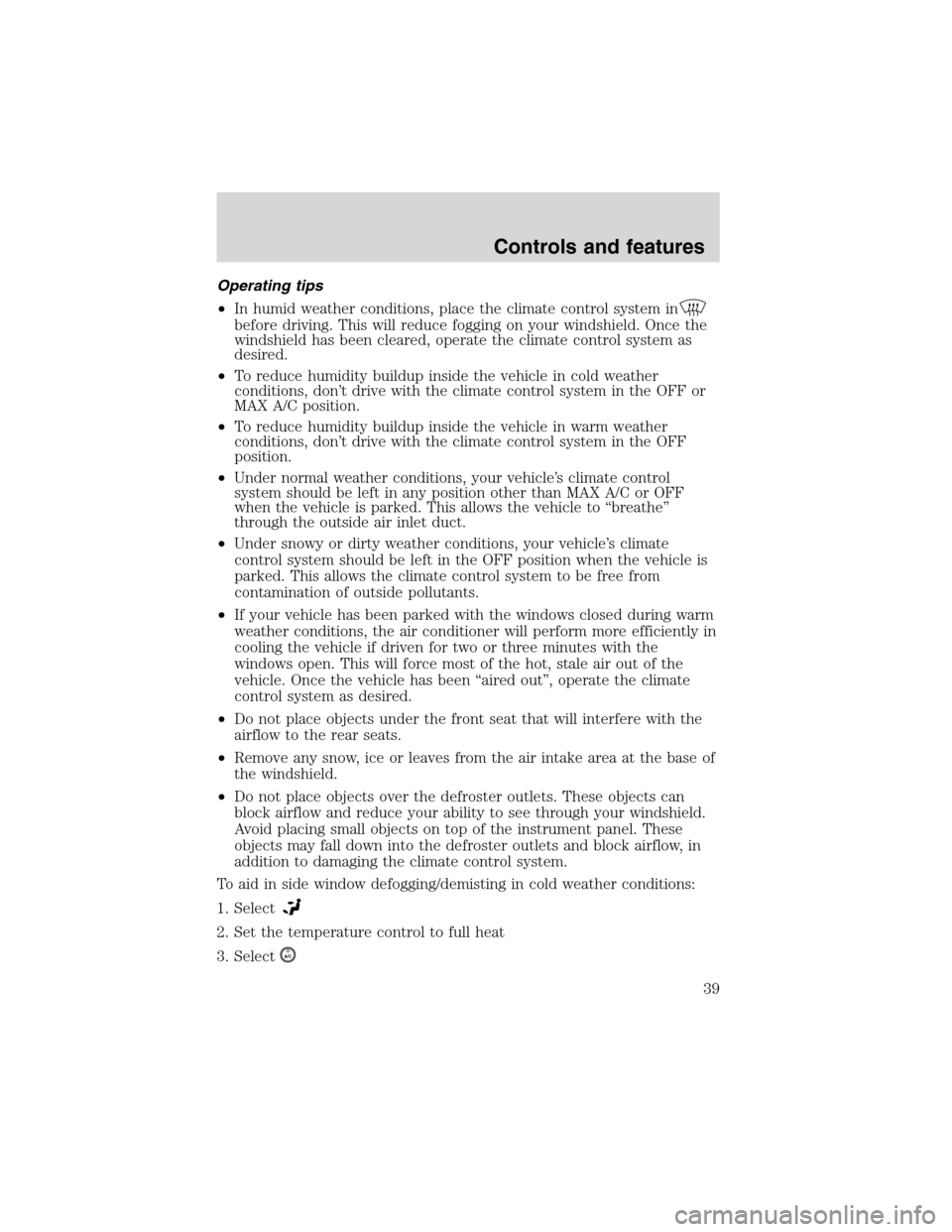
Operating tips
•In humid weather conditions, place the climate control system in
before driving. This will reduce fogging on your windshield. Once the
windshield has been cleared, operate the climate control system as
desired.
•To reduce humidity buildup inside the vehicle in cold weather
conditions, don’t drive with the climate control system in the OFF or
MAX A/C position.
•To reduce humidity buildup inside the vehicle in warm weather
conditions, don’t drive with the climate control system in the OFF
position.
•Under normal weather conditions, your vehicle’s climate control
system should be left in any position other than MAX A/C or OFF
when the vehicle is parked. This allows the vehicle to“breathe”
through the outside air inlet duct.
•Under snowy or dirty weather conditions, your vehicle’s climate
control system should be left in the OFF position when the vehicle is
parked. This allows the climate control system to be free from
contamination of outside pollutants.
•If your vehicle has been parked with the windows closed during warm
weather conditions, the air conditioner will perform more efficiently in
cooling the vehicle if driven for two or three minutes with the
windows open. This will force most of the hot, stale air out of the
vehicle. Once the vehicle has been“aired out”, operate the climate
control system as desired.
•Do not place objects under the front seat that will interfere with the
airflow to the rear seats.
•Remove any snow, ice or leaves from the air intake area at the base of
the windshield.
•Do not place objects over the defroster outlets. These objects can
block airflow and reduce your ability to see through your windshield.
Avoid placing small objects on top of the instrument panel. These
objects may fall down into the defroster outlets and block airflow, in
addition to damaging the climate control system.
To aid in side window defogging/demisting in cold weather conditions:
1. Select
2. Set the temperature control to full heat
3. Select
A/C
Controls and features
39
Page 42 of 312

reduce window fogging. Additionally, if the engine is not warm enough to
provide heat, the fan will operate at a low speed and the airflow will be
directed to the windshield or to the floor. The fan speed will start to
increase and the airflow location will change to the floor area.
If unusual conditions exist (window fogging, etc.), the manual override
controls allow you to select airflow locations as necessary. To return to
full automatic control, press the AUTO control.
Single/dual electronic temperature zone
Press DUAL to enable or disable the dual zone temperature feature.
When DUAL is pressed, the display window indicates the current
temperature setting for the driver and the last temperature setting that
was selected for the passenger. In addition to the DUAL control, the
passenger may engage the dual temperature zone feature by pressing the
passenger side temperature control.
The DUAL indicator will be lit when the dual temperature zone feature is
selected.
AUTO OFFDUAL A/C
R EXT
F C
FF
Controls and features
42
Page 44 of 312

Fan speed ()
When AUTO is pressed, fan speed is adjusted automatically for existing
conditions. You can override fan speed at any time. To control fan speed
manually, press the fan control to cancel the automatic fan speed
operation. Press the control up for higher fan speed or down for lower
fan speed. The display will show
and a bar graph to indicate manual
fan operation and relative speed.
When the fan is adjusted in the AUTO mode, the AUTO indicator will
remain lit and the system will remain in auto operation.
To return to automatic fan operation, press AUTO. The fan icon and bars
will disappear from the display, and the DEATC system will return to full
automatic operation.
•A/C control
A/C(air conditioning)—Used to manually enable or disable the
operation of the air conditioning in all modes except
and.In
all modes, the air conditioning will only function if the outside
temperature is about 6°C (43°F) or higher. When manual A/C is selected
(ON) the indicator will be lit. When manual A/C is selected (OFF) the
indicator will not be lit.
AUTO DUALOFFA/C
R EXT
F C
FF
AUTO DUALOFFA/C
R EXT
F C
FF
Controls and features
44
Page 45 of 312

Inand, if the outside temperature is about 6°C (43°F) or
higher, the air conditioner will automatically dehumidify the air to reduce
fogging. However, the A/C indicator will be off and the A/C override
control cannot be selected.
The air conditioning compressor can operate in all modes except OFF.
However, the air conditioning will only function if the outside
temperature is about 6°C (43°F) or higher.
Since the air conditioner removes considerable moisture from the air
during operation, it is normal if clear water drips on the ground under
the air conditioner drain while the system is working and even after you
have stopped the vehicle.
When AUTO is selected, the A/C operates automatically for existing
conditions. However, the A/C indicator will not be lit. If A/C is selected
when in AUTO operation, the DEATC system will be disabled and you
will return to manual operation with the A/C indicator lit.
To return to automatic A/C operation, press AUTO.
•Recirculation control
(air recirculation)—Used to manually enable or disable
recirculated air operation in all modes except
and. The use of
recirculated air when the air conditioning is operating helps to reduce
the amount of time to cool down the interior of the vehicle in very hot
conditions. Recirculated air may also help to keep undesired outside
odors from reaching the vehicle interior. It is recommended to allow the
DEATC system to automatically control the selection of outside or
recirculated air.
The recirculation control cannot be selected in
or, as interior
fogging may occur.
When AUTO is selected, the recirculated air feature operates
automatically for existing conditions. However, the air recirculation
AUTO DUALOFFA/C
R EXT
F C
FF
Controls and features
45
Page 46 of 312

indicator will not be lit. If the recirculated air is selected while in AUTO
operation, the DEATC system will be disabled and you will return to
manual operation with the recirculated air indicator lit and with the A/C
operating.
To return to automatic recirculated air operation, press AUTO.
Do not leave the DEATC system in recirculated air operation for
extended periods of time while the system is in a heating mode or in
cold/damp conditions as this may cause interior fogging of the front, side
and rear windows.
Manual override controls
The manual override controls allow you to manually determine where
airflow is directed. To return to fully automatic control, press AUTO.
When a manual airflow override control is selected, the DEATC system
will turn off the AUTO indicator and display the indicators of all
operating override controls. More than one override control indicator
may turn on when an override control is selected.
•Airflow direction control
(panel)—Distributes air through the instrument panel registers.
(panel/floor)—Distributes air through the instrument panel
registers and the front seat floor ducts. For added customer comfort, the
air distributed through the floor ducts may be slightly warmer than the
air sent to the instrument panel registers.
(floor)—Distributes air through the front seat floor ducts. The
system will allow some airflow out the window defroster ducts and the
demister outlets.
(floor/defrost)—Distributes outside air through the windshield
defroster ducts, the demister outlets and the front and rear seat floor
AUTO DUAL
A/C
R EXT
F C
FF
OFF
Controls and features
46